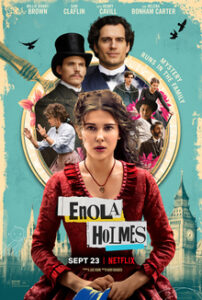 “Enola Holmes” has all the hallmarks of a classic detective movie: a mysterious disappearance, a chase through a moving train, ciphers and several clever disguises. Yet, other important elements fall flat.
“Enola Holmes” has all the hallmarks of a classic detective movie: a mysterious disappearance, a chase through a moving train, ciphers and several clever disguises. Yet, other important elements fall flat.
As a Netflix Original movie, “Enola Holmes” released on Sept. 23, follows Enola Holmes (Millie Bobby Brown), sister of Sherlock (Henry Cavill) and Mycroft (Sam Claflin), as she tries to solve the mystery of her mother’s (Helena Bonham Carter) disappearance.
The movie opens with a narration from titular character Enola, who describes her childhood with her mother. Her father died when she was very young, and her brothers Mycroft and Sherlock moved out soon after.
Enola and her mother had each other, and they spent their time reading, playing chess, and practicing fighting techniques. Needless to say, Enola was raised to be quite different than the typical teen girl living in the 1900s.
On the morning of her 16th birthday, Enola wakes up to an empty house.
Her mother is nowhere to be found.
Soon after, Mycroft and Sherlock arrive to handle the situation.
Enola becomes Mycroft’s ward, and Mycroft, upon seeing that Enola does not act the way a proper young lady should, elects to send her to a finishing school.
Horrified at this prospect, Enola runs away, boarding a train to head to London where she will search for her mother.
On the train Enola meets a stowaway, Lord Viscount Tewksbury (Louis Partridge), also on the run from an equally dreadful future. Despite her attempts to rid herself of Tewksbury, she finds herself caught up in the politics Tewksbury was running away from.
The movie certainly isn’t perfect. But it does do a few things right.
For one, the movie is a delight to watch. It’s packed with action sequences, well-choreographed fights and menacing villains.
The cinematography is beautiful, as well. The lighting and environments perfectly combine to create an atmosphere that is vibrant and alive, or, when necessary, suffocating and oppressive.
Throughout the course of the film, Tewksbury and Enola find themselves in a variety of tense situations, which add to the drama and suspense in the last act of the film. However, on several fronts, I was disappointed.
For one, there are multiple fourth wall breaks by Enola, who often makes eye contact with the viewer to deliver a quippy one-liner or a comedic expression.
The way Enola interacts with the viewer is mostly for comedic effect or exposition, and if it were eliminated the film would be much stronger.
For example, Enola delivers to the viewer a brief history of her family, but this information is easily gleaned through the dialogue of the characters. There is no need to tell the audience what can be shown.
Also, at the end of the movie, a moment of complex emotion is interrupted by an overly cheery, stereotypical and oversimplified summary of the lessons Enola learned from the experience. I would have preferred the movie to end with a genuine moment, not with the main character telling me what I should have learned.
Another disappointing feature is the romantic subplot. While the actors had chemistry and the romance was sweet, it was completely unnecessary to the plot of the film. There is often the notion that a woman needs a romance to truly find herself and be completed.
By including a romantic interest for Enola the film only furthers this stereotype. There was a missed an opportunity to show a rarely represented positive platonic relationship between a boy and a girl.
The message behind the movie was clear but overly simplified. The movie proposes a dichotomy in which women can either happily embroider and keep the house or they can be vigilant, clever and able to fight.
But why are these two things opposite to each other?
The movie sets out the prove that women are be just as capable and clever as men, which is true.
However, in order to have her thoughts and insights recognized as valuable, a woman should not have to prove herself by demonstrating her capability for masculinity.
Feminine or not, a woman’s voice should be heard, not because she’s a woman but because she’s a person.
The movie is saying “Look! Women can be masculine, too!” and the movie is right, but that’s not what’s important.
The more interesting idea to consider is why is masculinity considered more valuable than femininity?
Instead of successfully arguing that women are inherently respectable and important, the movie reinforces the idea that in order to be heard, a woman must not want a life of domesticity and comfort. In order to be heard, she must break the mold.
The way the message was delivered is another missed opportunity to explore something a little more complex. Perhaps the movie could have delved into the concept that the domestic life path is not the ideal choice for everyone but it is still a valid choice.
A woman choosing to have a domestic life is not the issue. The issue is when it is forced upon her.
Time and time again, the movie falls into the trap of oversimplicity.
Enola is discriminated against when people think she’s poor, but when she pulls out a wad of cash, people immediately change their behavior. All the villains in the movie aim to silence women or maintain the status quo.
It is fairly agreed-upon and uncontroversial to say that classism, misogyny and resistance to change are bad, especially when these messages are delivered with no nuance.
“Enola Holmes” is a movie about a remarkable teen girl, but instead of being a remarkable movie, it took the easy way out.

